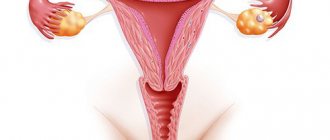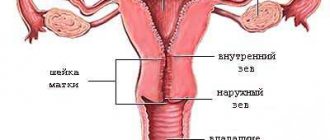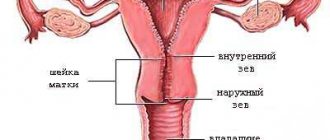Cervical erosion is one of the most common gynecological diseases, which almost every 5th woman encounters during her life, and sometimes more than once. However, erosion cannot be called a harmless condition. Although it is almost asymptomatic and can persist for years, over time, pathological changes in the mucous membrane of the cervix progress and ultimately can develop into cancer, which annually claims tens of thousands of women's lives. Therefore, it is important at least once a year, and preferably every six months, to make an appointment with a gynecologist, and if cervical erosion is detected, immediately undergo examination and begin treatment.
Doctor's comment: Almost every woman in her life has heard about such a disease as cervical erosion; many were diagnosed with this and treated, but, unfortunately, not all patients managed to solve this problem. The question arises: “Why?..”
What is erosion
The content of the article
Pathology is a defect in the mucous membrane, which can occur against the background of infections, injuries or hormonal disorders and have varying severity, which will determine the method of treatment.
There are true erosion, pseudo-erosion and ectropion. With all these pathologies, a bright red area of damaged or modified epithelium appears on the cervix around its pharynx - this is what the upper layer of cells is called in medicine.
This disease affects women of any age. Most cases occur during the reproductive period and later; about 12% of patients are teenage girls. Gynecologists state that during routine examinations one of the types of erosion is detected in every second patient.
Consequences of cauterization
If cauterization was carried out justifiably, in the presence of strict indications, the procedure itself was carried out by a qualified specialist, the consequences will be minimal. Undesirable effects may occur after treatment:
- Pain in the chest and lower abdomen - this condition occurs for 2-3 days and is considered normal. If the pain does not go away within 1 week, you should consult a specialist.
- Relapse, when erosion occurs again after cauterization. Repeated cell damage occurs for the same reasons that ectopia initially appeared - HPV carriage, regular cervical injury, hormonal imbalance. But most often, erosion recurs during pregnancy due to hormonal changes in the body. In this case, the disease may go away on its own after delivery.
- Scar on the cervix. This phenomenon practically does not occur after treating erosion with radio waves or a laser; with other types of cauterization it occurs as an undesirable effect. Scars and deformations subsequently lead to problems with conception and miscarriage.
- Discharge. A dangerous side effect is bleeding - it sometimes occurs immediately after the procedure and lasts for several days, rarely even requiring hospitalization of the patient. The main cause of bleeding is damage to healthy tissue. Scanty discharge with blood disappears 10 days after the procedure. Such leucorrhoea has a liquid consistency and is odorless and does not cause discomfort.
Depending on the results of cauterization and the choice of procedure method, a woman rarely experiences individual side effects, for example, intolerance to the components for chemical cauterization, increased pain, and menstrual disorders.
Types and causes of erosion formation
This group of diseases combines several different processes, but they all relate to changes in the upper layers of the cervix.
- True erosion.
Appears as a result of mechanical damage to the cervix during unsuccessful medical procedures or due to erosion of the mucous membrane by pathological secretions - they often have high acidity. The eroded area visually represents a wound with a bleeding surface. - Pseudo-erosion (ectopia)
. With pseudo-erosion, the squamous cervical epithelium (the normal shape of the covering cells) is replaced by a cylindrical one. Cylindrical cells do not perform a protective function, therefore they are foreign and dangerous to the organ. Without treatment, pathological cells grow and penetrate deep into healthy tissues. - Ectropion
. This is the internal portion of the cervix that protrudes outward (outside the cervical canal). Formed when tissue is damaged or may be a congenital pathology. In this case, everything happens the other way around: the inner layer of cylindrical cells, appearing on top, enters the vaginal environment, which is unusual for it (for example, when the cervix is dissected), is destroyed, replaced by multilayered squamous epithelium (the delicate skin becomes coarser).
Pseudo-erosion, in turn, can be:
- Papillary
- having papillary growths; - Follicular (glandular)
- the glands of the uterus grow in the lesion, due to their excessive elongation, cavities are formed - cysts; - Metaplastic
- having areas of replacement of one type of epithelium by another. For example, with the so-called atypical degeneration, the surface of the eroded area is mosaic, consisting of normal cells, altered vessels and glands. - Mixed
, combining signs of several forms of the disease.
The gynecologist determines exactly what type of erosion the patient has using extended colposcopy.
Reviews
I am writing to help those who have erosion and who think that it is nothing to worry about. I also had erosion and for 15 years I thought that everyone had it and nothing needed to be done about it until I accidentally came to Zhanna Georgievna. She said that I have endocervicitis and erosion and, possibly, leukoplakia - since there is a white coating on my cervix. Anyone who knows what it is will understand me. The doctor took a smear from me for cytology. Those days that I waited for an answer were terrible, because I didn’t even give birth. Fortunately, the cytology came back good. Zhanna Georgievna said that it is necessary to do laser cauterization of the erosion to prevent anything bad from happening. That's what we did. It was very unpleasant, but it does not compare with the sensations that the girls describe from other types of cauterization of erosion. Or maybe I was lucky with the doctor. In any case, thank you very much. And, girls, treat erosion before it’s too late! Laser cauterization is the most effective way!
Milana (Solnechnogorsk, 2014)
After the New Year holidays, I began to be bothered by vaginal itching and spotting. I immediately went for an examination, which revealed that I had cervical erosion. I read reviews on cauterization and decided to do laser as the safest way. That’s how I found the Lama clinic, which specializes in surgical gynecology. I must say that I immediately liked the clinic. The administrator explained everything to me very competently and made an appointment with a gynecological surgeon. After the appointment, they did some tests on me, and when the results came back, they scheduled surgery. The operation itself is simple. Not much different from a regular inspection. I even thought it would be worse. A month later I came for an examination and repeated tests. Everything went away, the infections also went away after the course of treatment. I’m very glad that I came across them, and I found them by chance on the Internet. Now I will always go to them for women’s issues.
Alevtina (January 2014)
I did laser cauterization of cervical erosion here six months ago. The doctor has a light hand, everything was tolerable. I bled for 4 days after cauterization, the cycle was a little off, but now everything is fine. On re-examination there is no erosion. Now you can get pregnant. By the way, my previous doctor told me that after giving birth the erosion would go away - nothing like that: after the first birth, endocervicitis also began against the background of erosion! Thanks to the Lama clinic and my doctor - Zh.G. Muradova.
Anyuta (Moscow, 2014)
When my husband and I decided to have a child, we started getting checked. I went to my gynecologist just for a routine examination and was very surprised that I had erosion. Nothing bothered me at all, there was no discharge or pain. It’s good that we discovered it when the erosion was very small. Apparently the process has just begun. The gynecologist advised me to do cauterization with a laser. In general, I was afraid at first, but then I read on the Internet that this is not a very scary procedure and I calmed down. I did it at my Lama clinic, where I prepare for pregnancy. Everything went very quickly and efficiently. I didn't even have to undergo anesthesia. I even thought it would be worse. Now I am doing a treatment program for STDs that I was diagnosed with. I want to close all questions before pregnancy. I recommend Lama. I’ve been going to them for gynecology for 5 years now; I haven’t seen a better clinic yet. And the prices are moderate. They do not advertise for unnecessary tests and procedures. Everything is to the point.
Irina (Moscow, November 2013)
About three months ago I began to notice that the discharge had an unpleasant odor. I went to the clinic to see a gynecologist for an examination, and she told me that I had cervical erosion and inflammation. But I didn’t like the doctor at all, so I decided not to be treated by her, but to look for something better. I asked my friends, they advised me to contact Lama. I came to see Muradova. I really liked her right away, not only as a doctor, but also as a person. I did all the tests at once at the first visit, and a week later I had cauterization done. They have a special laser in the clinic, which has very good reviews on the Internet. They prescribed me a course of treatment (they found a whole bunch). Overall everything went great. It doesn't hurt at all. In about 20 minutes they cauterized me, and I went home. I highly recommend Muradova. Skillful fingers.
Olga (Moscow, May 2013)
Articles on the topic
Cervical erosion: consequences
Many women face such a disease as cervical erosion. Erosion is a benign pathological process of degeneration of the epithelial cells that cover the cervix. If you do not neglect the disease and take the necessary measures, then after treating cervical erosion, a woman may […]
Pregnancy with cervical erosion
Women who have been diagnosed with a disease such as cervical erosion are concerned with the question of how dangerous this disease is and, most importantly, whether it is possible to become pregnant with cervical erosion. Erosion can be triggered by various reasons, both inflammatory processes and hormonal […]
Symptoms of uterine erosion
Often this disease does not produce pronounced symptoms, being detected only during a colposcopic examination by a gynecologist (standard examination using a special device), but sometimes the disease manifests itself with the following symptoms:
- The presence of light yellow, whitish or bloody cloudy discharge, sometimes with an unpleasant odor;
- Light bleeding, expressed in the appearance of a small amount of blood in the form of drops or smears after sexual intercourse.
To determine the direction of therapy as accurately as possible, specialists prescribe a comprehensive laboratory test, colposcopy and other diagnostic measures.
Contraindications
It is necessary to ensure that there are no contraindications before cauterizing the erosion, for which the woman is prescribed a whole range of studies. The main restrictions are:
- blood clotting disorders;
- malignant degeneration of tissues of the eroded area;
- sexually transmitted diseases (in acute or chronic stages);
- inflammatory processes in the genitourinary system;
- manifestation of signs of bleeding;
- pregnancy, less often - breastfeeding;
- early period after childbirth, the presence of lochia;
- installed IUD;
- history of caesarean section;
- diabetes;
- HPV carriage;
- exacerbation of any chronic disease.
Not all methods of cauterization of cervical erosion are universal; if the damage to the epithelial area is significant, only a few methods are suitable.
If the principles of contraindications are not followed, various complications may occur after the procedure. That is why at the stage of early examination it is necessary to take blood tests (biochemical and general), urine, smears, cytology and others to determine the woman’s hormonal status and the absence of bacterial and viral inflammation.
Why is colposcopy necessary?
A definitive diagnosis of erosion can only be made with colposcopy. After treating the cervical surface with Lugol's solution, all existing defects become noticeable:
- With true erosion, a bright red area of desquamated epithelium is detected, on the surface of which the vessels are clearly visible.
- With pseudo-erosion, an area of replacement of healthy multilayered squamous epithelium with areas containing pathological glands, cysts, and unusual cells is visible.
- With ectropion, an inversion of the tissues of the cervical canal into the vagina is detected. The affected neck has a bright red eroded surface. Scar tissue changes are often observed.
For final diagnosis, a cytology smear is taken to find out what cells the modified area consists of. If a gynecologist discovers cancer cells, the disease moves from the category of erosions to oncological ones. This is why erosion is dangerous - without treatment it can increase, become infected and transform into uterine cancer.
Cervical biopsy
Erosion
- This is a defect in the epithelium of the cervix, located on the side of the vagina, on the external pharynx. The disease is asymptomatic or is accompanied by muco-bloody-purulent discharge after sexual intercourse and nagging pain in the sacral area. Erosion occurs due to endocervicitis, trauma and other reasons that cannot always be identified. Cervical erosion can occur even in adolescents, before sexual activity begins. The most popular treatment methods are laser vaporization, diathermocoagulation, radio wave and cryodestruction.
This is one of the most common gynecological diseases
- occurs in approximately
15%
of women. If erosion lasts a long time, recurs and stubbornly does not respond to treatment, and also has signs of dysplasia, then it is considered a precancerous pathology. The prognosis is significantly aggravated by the presence of human papillomavirus types 16 and 18 in a woman’s vagina.
Pathogenesis
of Cervix
- This is the lower edge of the uterus, which protrudes into the vagina in the form of a bulge. Due to this location, it is susceptible to increased injury during sexual intercourse and medical procedures. In addition, the epithelium of the cervix is not as protected as the vaginal epithelium, but is in the same aggressive and bacteria-filled environment, therefore, it is primarily affected by infections. Polyps and tumors easily form here.
Causes
The causes of erosion can be different. In some cases, it is not possible to establish the exact cause, since several negative factors are present at once. In modern medicine there are several theories of the occurrence of the disease:
- inflammatory theory
— erosion occurs as a consequence of the inflammatory process in the cervix;
- dishormonal theory
— it is suggested that erosion may appear as a reaction to a certain level and ratio of sex hormones (for example, during pregnancy);
- traumatic theory
- during childbirth or curettage, cervical inversion may occur and then erosion occurs.
Types of cervical erosions
Experts divide erosion into true, pseudo-erosion and congenital. Let's take a closer look at the features of each type.
True erosion
The defect is damage and desquamation of the epithelium in the area of the external uterine os. The surface is a wound with signs of an inflammatory process. Most often, true erosion occurs due to inflammatory diseases of the female genital area, for example, endocervicitis.
True erosion is bright red in color and begins to bleed very easily when touched by foreign objects. Colposcopy reveals swelling, infiltration, dilated vessels, and discharge consisting of blood, fibrin, mucus and pus. Typically, true erosion lasts only a few weeks, and then goes into the healing stage, which in professional language is called pseudo-erosion.
Pseudo-erosion
If there is no epithelium in true erosion, then in pseudo-erosion the defect is already replaced by columnar epithelial cells that grow from the cervical canal. These columnar epithelial cells visually appear brighter red than the surrounding squamous epithelium of the cervix. Replacement of squamous epithelium with cylindrical epithelium is the first stage of healing of an erosive defect. It grows in depth, forming glandular passages where erosive glands are located. They produce secretions, which often stagnate in branched passages and form cysts of various sizes. Large cysts can be accidentally confused with cervical polyps.
Pseudo-erosions are:
- follicular (glandular) - with cysts and glandular ducts;
- papillary - with papillary growths (in the form of papillomas) on the surface;
- mixed - including both elements.
Pseudo-erosion
contains a chronic source of inflammation that occurs in its glands, ducts and cysts. This process can take months and years. Rarely does it stop on its own, more often as a result of treatment. Pseudo-erosions are also easily damaged and bleed, especially during pregnancy. If the inflammatory process subsides, the erosion heals completely - the columnar epithelial cells are replaced back by flat ones, but the cysts may remain. Complete healing of the defect is characterized by the disappearance of columnar epithelium and erosive glands and the appearance of squamous epithelium over the entire surface.
Congenital erosion (ectopia)
This is simply a displacement of the columnar epithelium outside the cervical canal. Occurs in girls during the prenatal period. This ectopia is bright red in color and covered with columnar epithelial cells, but there are no glandular ducts or signs of inflammation. In childhood, ectopia does not progress, but after puberty they can become infected and turn into true erosion. There is practically no malignant degeneration of ectopia, in contrast to erosions that appear at a more mature age.
Diagnostics
The doctor diagnoses the presence and condition of erosion through colposcopy and examination of the cervix using mirrors. If there is a suspicion of the development of a malignant process, then the erosion is treated with iodine and the presence of white and yellow lesions is checked by colposcopy. The erosion itself is pink, dysplasia is yellow, and atypical lesions are white. If foci of dysplasia are detected, a biopsy of the material from them is performed and its histological examination. Erosion with the presence of foci of dysplasia is considered a precancerous condition.
Treatment
Treatment varies depending on the type of erosion and its condition:
- birth defects are not treated;
- other types of erosions should be treated together with background inflammatory pathologies of the vagina and uterus;
- in case of inflammation, it is necessary to carry out targeted therapy against pathogens (chlamydia, trichomonas, gonococci, etc.);
- erosion in the acute stage of inflammation (true) is treated with fish oil, sea buckthorn oil, syntomycin, chloramphenicol, etc.);
- Erosion in the chronic stage (pseudo-erosion) is supposed to be subjected to destruction.
Methods for removing erosion
If you cut off or otherwise remove all the erosion tissue, then normal squamous epithelial cells often grow in its place. Removal of erosive tissue is carried out using different methods, each of which has its own characteristics.
- Diathermocoagulation
- cauterization with high frequency electric current. The method has a high risk of subsequent scarring, so it is not used in women who are still planning to give birth. Rehabilitation after diathermocoagulation is 2 months. Endometriosis often occurs as a complication, so to reduce the risk, surgery should be performed in the second phase of the monthly cycle.
- Laser vaporization
— removal of erosion with a laser beam. In this case, the risk of scar formation on the cervix is much lower, so the procedure is prescribed for patients planning pregnancy. Rehabilitation after surgery takes about a month. The procedure is carried out on days 5-7 of the monthly cycle.
- Cryodestruction
— freezing of eroded tissue with liquid nitrogen. The operation is bloodless and painless, and does not cause the risk of scarring of the cervix. The rehabilitation period is 1.5 months.
- Radio wave removal of erosion
carried out using the Surgitron apparatus. Erosion is burned out by high frequency radio waves. This method has the lowest risk of scarring, so it is often recommended for women still planning childbirth.
After removing erosion using one of these methods, the woman should be under the supervision of a gynecologist for a year. Removal of erosion is possible only after careful exclusion of oncological degeneration, for which an extended colposcopy and biopsy of suspicious areas are performed. If an oncological process is confirmed, these methods are not used, but radical surgery is immediately started.
Is it necessary to treat erosion?
Timely treatment of erosion allows you to avoid the development of serious infectious and inflammatory processes, since the pathological area of tissue is an open gate for various pathogens. In addition, long-term untreated erosion may be accompanied by bleeding and the appearance of uncharacteristic vaginal discharge, which complicates sexual activity and causes discomfort in the woman.
An even greater danger is the degeneration of eroded tissues into cancerous ones. This, alas, also happens not so rarely.
How does a doctor determine the treatment method?
Having carefully studied the patient’s condition, determined the degree of development and depth of erosion, and also identified its cause, the gynecologist, based on the data obtained, determines the method of treatment that can have the maximum impact on the leading factor that caused the disease.
If an infectious-inflammatory process is observed, the gynecologist will prescribe antibiotics. Traumatic erosion requires a different treatment method. In this case, doctors most often recommend removing the damaged part of the tissue using one of the modern methods. Various techniques are used to treat erosion, the choice of which depends on the equipment of the clinic, the type of erosion and the capabilities of the patient.
Today, instrumental methods for eliminating erosion, such as laser destruction, electrocoagulation, radio wave surgery and cryodestruction, are considered the most effective and safe.
All of the methods listed are either completely painless, for example, laser, or simply unpleasant (electrocoagulation). In any case, a good doctor will not allow the patient to experience pain, so there is no need to be afraid of these procedures. If the pain threshold is high, modern anesthesia is used to relieve pain.
Prices
Price (RUB) In installments* (RUB) Consultation with a surgeon on the operation (SPECIAL)0—Online doctor’s opinion on the operation (SPECIAL)0—Treatment of erosion, leukoplakia of the cervix using radio wave surgery, Cat. I. complexity from 5050—Treatment of erosion, leukoplakia of the cervix using radio wave surgery, category II. complexity from 7100—Treatment of erosion, leukoplakia of the cervix using radio wave surgery, category III. complexityfrom 9100—* You can read more about the conditions here - Treatment on credit or in installments
The cost is preliminary. The exact cost of the operation can only be determined by a surgeon during a free consultation.
How to treat erosion correctly and how do treatment methods differ?
The methods pursue the same goal, but they use various physicochemical phenomena to destroy pathological cells. Thus, electrocoagulation is defined as the “cauterization” of tissue using an electric current, while cryodestruction involves exposing the pathological area to extremely low temperatures of liquid nitrogen.
- Diathermoelectrocoagulation
– cauterization of a surface with high frequency electric current. The procedure is carried out immediately after the end of menstruation. After treatment, a crust (scab) forms at the cauterization site, which disappears after a few days. The disadvantages of the method are pain, prolonged healing, the possibility of scarring and deformation. Currently rarely used. - The use of solutions:
Solkovagin, Vagotil, etc. allows you to do without cauterization. This method is gentle and low-traumatic, but requires several visits to the doctor, and for deep lesions it is not very effective. - Cryodestruction
- the erosion surface is treated with carbon dioxide or liquid nitrogen. As a result of cold exposure, atypical tissues are destroyed and die. By adjusting the percentage of refrigerants, you can increase or decrease the depth of exposure to tissue. The method is effective, painless, and does not cause scarring. The disadvantage is the impossibility of removing tissue for analysis and the difficulty of using it for deep lesions. - Laser coagulation
is the effect on the surface of erosion using a laser. A precisely focused beam allows you to carefully remove damaged tissue without damaging healthy epithelium. The laser method is characterized by rapid recovery and minimal complications. - Radiotherapy
- cells are vaporized using radio waves. This technique does not cause pain and does not leave scars. Excellent for the treatment of erosion in nulliparous women.
A very effective and at the same time safe technique for removing erosion is laser correction, which differs in the direction of action and allows you to avoid the formation of scars and scars in the cervical area. Another excellent innovative technique is radio wave surgery, which uses radio waves as a destructive factor for pathological cells. That is why this method has been chosen as the main one at the Diana Clinic.
Benefits and cost of the procedure
Patients who have undergone radio wave therapy note such advantages as:
- no bleeding;
- short recovery period;
- zero risk of postoperative complications;
- painlessness;
- absence of scars and other defects in the affected tissue areas;
- the ability to plan a pregnancy 2-3 months after surgery.
At the moment, we can confidently say that radio wave therapy is a high-tech and promising technique that can completely eliminate gynecological pathology without interfering with a woman’s reproductive function. It can also be considered one of the most gentle methods. The technique not only does not affect the very possibility of getting pregnant, but is also not capable of creating negative preconditions for problems with the course of the birth process in the future.
The procedure requires the use of high-tech medical equipment, the involvement of experienced doctors and serious training. That is why it is quite expensive. However, the price is completely justified, since the procedure gives long-term results and guarantees the absence of serious complications. The cost of the intervention will depend on the size, etymology and nature of the erosive process.
Additional Methods
Anti-inflammatory and even painkillers can be prescribed as additional symptomatic medications. But again, the gynecologist decides how to treat cervical erosion.
It should be remembered that cervical erosion is considered a probable precancerous condition, neglect of which can lead to malignant tumors. Various anti-inflammatory and bactericidal baths and lotions can only be used as an addition to the main treatment prescribed by a professional doctor, with his permission.
Recovery period after cauterization of erosion
The procedure for instrumental cauterization, freezing or laser removal of erosion takes a minimum of time and does not require long-term rehabilitation. It is enough to abstain from intense physical activity and sexual activity for the first two weeks in order to protect yourself from infection and trauma to the site of exposure.
Many patients are interested in whether they can get pregnant after cauterization or removal of cervical erosion. The answer to this question is positive, since all the methods for removing pathologies described above do not have a damaging effect on the uterine tissues and cervical structures. If the patient becomes pregnant with erosion, it is recommended to postpone treatment until the postpartum period.
Diagnosis before laser treatment of erosion
Laser removal of erosion is carried out only after a thorough examination of the woman and a comprehensive examination. It includes the following procedures:
- smears for atypical cells and bacterial culture;
- laboratory tests of blood and urine;
- colposcopy;
- infectious diagnostics, detection of antibodies to HIV.
A week before the procedure, it is recommended to refrain from intimate contact. Laser vaporization is carried out after the end of menstrual bleeding. The gynecologist at our clinic will tell you in detail about the method and rules of preparation for it.







